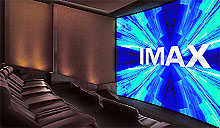Washington, July 13
MIT scientists have developed a new system that can allow users to watch 3D movies at home without having to wear inconvenient special glasses.
While 3D movies continue to be popular in theatres, they have not made the leap to our homes just yet.
Theatres generally either use special polarised light or project a pair of images that create a simulated sense of depth.
To actually get the 3D effect, though, users have to wear glasses, which have proven too inconvenient to create much of a market for 3D TVs.
Now, researchers from Massachusetts Institute of Technology (MIT) in the US aim to change that with ‘Home3D’, a new system that converts traditional 3D movies from stereo into a format that is compatible with so-called ‘automultiscopic displays’.
These displays are rapidly improving in resolution and show great potential for home theatre systems, researchers said.
“Automultiscopic displays are not as popular as they could be because they cannot actually play the stereo formats that traditional 3D movies use in theatres,” said Petr Kellnhofer, from MIT’s Computer Science and Artificial Intelligence Laboratory (CSAIL).
“By converting existing 3D movies to this format, our system helps open the door to bringing 3-D TVs into people’s homes,” Kellnhofer said.
Home3D can run in real-time on a graphics-processing unit (GPU), meaning it could run on a system such as an Xbox or a PlayStation.
The team said that in the future Home3D could take the form of a chip that could be put into TVs or media players such as Google’s Chromecast.
The algorithms for Home3D also let users customise the viewing experience, dialling up or down the desired level of 3D for any given movie, researchers said.
In a user study involving clips from movies including ‘The Avengers’ and ‘Big Buck Bunny’, participants rated Home3D videos as higher quality 60 per cent of the time, compared to 3D videos converted with other approaches.
Home3D converts 3D movies from “stereoscopic” to “multi-view” video, which means that, rather than showing just a pair of images, the screen displays three or more images that simulate what the scene looks like from different locations.
As a result, each eye perceives what it would see while really being at a given location inside the scene. This allows the brain to naturally compute the depth in the image.
Breaking News
 Driving Naari Programme launched in Chandigarh
Driving Naari Programme launched in Chandigarh Punjab farmers reaping benefits of Mann Government’s crop diversification initiatives
Punjab farmers reaping benefits of Mann Government’s crop diversification initiatives Punjab and Kerala Join Hands to Address NRI Concerns
Punjab and Kerala Join Hands to Address NRI Concerns Macron refuses French Prime Minister’s resignation after chaotic election results
Macron refuses French Prime Minister’s resignation after chaotic election results Modi lands in Russia for first visit since Ukraine offensive
Modi lands in Russia for first visit since Ukraine offensive Saudi Arabia approves granting citizenship to global experts under Vision 2030
Saudi Arabia approves granting citizenship to global experts under Vision 2030 Vigilance arrests Panchayat Secretary, former Sarpanch for embezzlement in Panchayat funds
Vigilance arrests Panchayat Secretary, former Sarpanch for embezzlement in Panchayat funds Housing crisis in Canada forcing residents to move out of pricier cities: Poll
Housing crisis in Canada forcing residents to move out of pricier cities: Poll Historic Milestone: Canada Appoints Its First Female Chief of Defense
Historic Milestone: Canada Appoints Its First Female Chief of Defense Victory parade of T20 World Cup-winning Indian cricket team concludes in Mumbai
Victory parade of T20 World Cup-winning Indian cricket team concludes in Mumbai Maximizing impact of Aadhar in Punjab
Maximizing impact of Aadhar in Punjab Amritpal Singh to take oath as Khadoor Sahib MP on July 5
Amritpal Singh to take oath as Khadoor Sahib MP on July 5




































